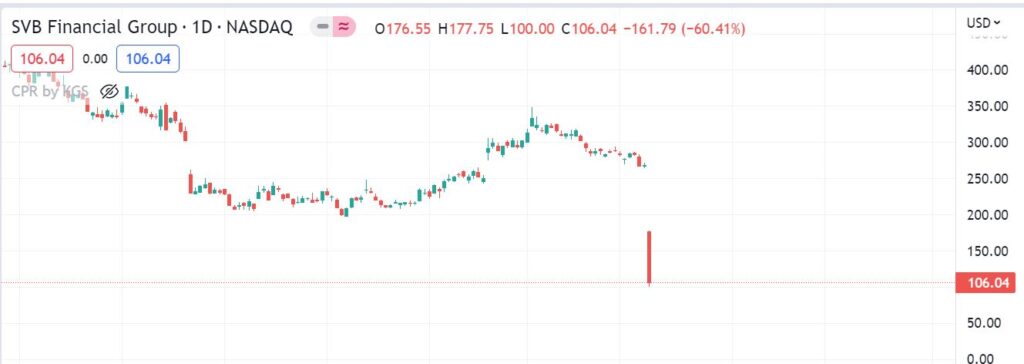Disruption in the tech investment ecosystem has spooked prominent venture capitalists everywhere after Silicon Valley Bank (SVB) Financial Group, a primary lender for tech startups, announced steps to raise funds after suffering bond losses—a deep dive into the show.
Silicon Valley Bank Shutdown By Regulators
The FDIC said that financial regulators shut down Silicon Valley Bank and took control of its deposits. Announced on Friday, it is the largest bank failure in the U.S. since the global financial crisis over a decade ago.
The collapse of SVB, a significant player in the world of technology and venture capital, has left companies and the wealthy uncertain about what will happen to their money.

The CDFPI (California Department of Financial Protection and Innovation) shut down SVB and appointed the FDIC as a receiver, according to a press release from the regulator. The FDIC, in turn, created the Santa Clara Deposit Insurance National Bank, which now holds the SVB’s insured deposits.
In an announcement, the FDIC said insured depositors could withdraw their deposits on Monday morning. At that time, SVB branches will also reopen under the regulator’s control.
What did Silicon Valley Bank do?
California-based SVB was founded in 1983 and focused on serving Silicon Valley startups.
In addition, it provides various services to venture capital and private equity firms and private banking services for high-net-worth individuals(HNIs).
How big is Silicon Valley Bank?
SVB does business with nearly half of the US-funded startups that went public last year and 44% of U.S. venture-backed technology and healthcare companies.
As of December 31, SVB has $212 billion in assets. The bank’s clients include household names such as Shopify and Pinterest.
What went wrong with SVB- A Crisp Timeline
∆ In the fundraising boom of 2021, SVB amassed huge deposits – $189 billion, then peaked at $198 billion.
∆ They invested heavily in bonds, which were at low-interest rates. SVB’s balance sheet at the end of 2022 showed $91.3 billion in securities. In 2022, the Fed began to raise interest rates, reducing the value of bonds issued at lower interest rates.
∆ Rising interest rates also caused V.C.s to issue fewer checks to startups, leading to a funding winter.
∆ Startup deposits with institutions such as SVB also began to decline as the Funding dried up, forcing banks to sell securities to prevent losses from being covered.
∆ On Wednesday, SVB announced it had sold $21 billion in bond assets for a loss of $1.8 billion.
∆ SVB also said it would raise $2.25 billion by selling shares.

On Wednesday, it surprised the world when Silicon Valley Bank announced that it had sold many securities at a loss and would sell $2.25 billion worth of new shares to strengthen its balance sheet. This sparked panic among major venture capitalists, who reportedly advised companies to withdraw funds from banks.
Silicon Valley Bank Collapse Affecting Many Indian Startups!
The sudden collapse of Silicon Valley Bank, a lifeline for startups, has also hit businesses 8,000 miles away.
Dozens of young Indian startups backed by companies like Y.C., Accel, Sequoia India, Lightspeed, SoftBank and Bessemer Venture Partners are already doing business with Silicon Valley Bank (sometimes their only banking partner) but cannot withdraw in time C so said the situation at the time, said several people familiar with the Funding.
Venture capitalists are reluctant to disclose the names of the startups involved, fearing it will affect the prospects of startups raising funds in the future. Regulators stepped in on Friday to shut down Silicon Valley Bank, the 16th-largest U.S. bank and most beginner benches.
Some Indian companies are unable to withdraw funds from Silicon Valley Bank on time because they have no other U.S. bank account immediately available, say many venture capitalists.
Many Indian startups are incorporated in Delaware to make raising capital from the United States feasible. Furthermore, some companies(SaaS) are registered in the U.S. because even though they are operating in India, they want to have exposure in the international market and be considered American companies.
For many companies are moving their headquarters to the United States. Another person said that Silicon Valley Bank is the top choice in India, noting that SVB sponsors many events in India as bank executives push for partnerships with Indian companies.
Almost all Indian SaaS startups with a significant U.S. presence have operations at Silicon Valley Bank, says a partner at a leading venture capital fund. In addition, multiple Indian SaaS unicorns and many others are based in the U.K.

SVB Share prices took a major correction within couple of trading session and kept the investors on their toes. It made a dip of $106.04 from recent highs. For more such content follow PrTechNews
